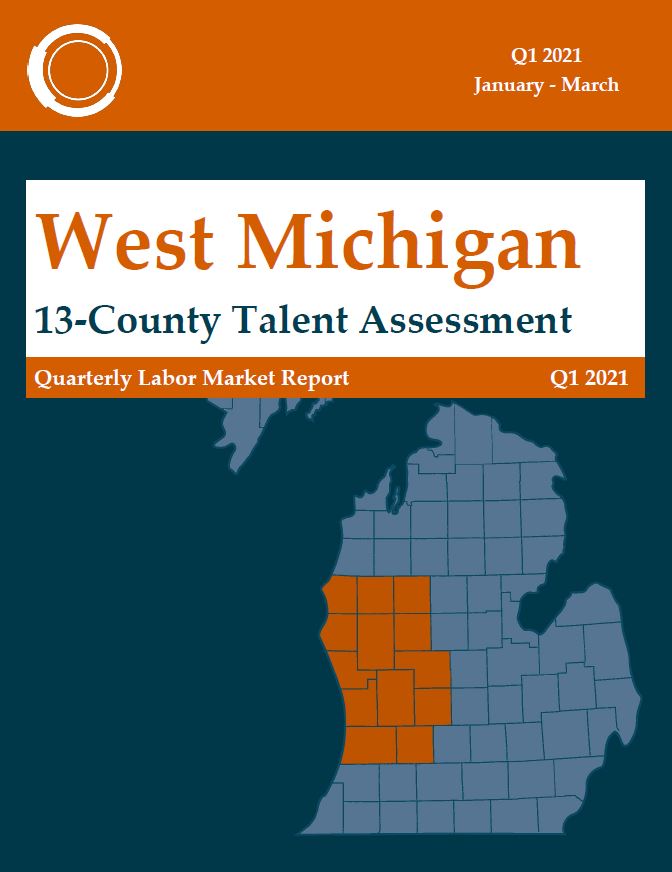This week marks the release of Talent 2025’s second quarterly labor market report in the series being released this year, spanning the first quarter of 2021. This report is a critical component of our effort to catalyze and align the talent system in West Michigan, with the provision of actionable data and analysis on in-demand occupations and the state of the labor force serving to inform, guide, and align workforce development efforts throughout the region. The report contains a more comprehensive analysis of the various economic indicators found below, which will be updated to reflect data from the second quarter of 2021 as more information becomes available.

The current state of West Michigan’s labor market and the demands of employers looks dramatically different from the release of our inaugural talent demand report in 2014. Today, regional unemployment stands at just over 4.7 percent, well below that of the state and nation. Although this remains higher than the historic low of 2.9 percent observed for the region before the onset of the pandemic, it is a significant improvement from the all-time high of 23.0 percent observed just a year ago. Despite a larger pool of available talent, a majority of employers still report difficulty finding talent to meet their needs and nearly half of jobseekers feel they lack the skills to qualify for available jobs — with low potential pay and childcare serving as additional barriers facing those seeking work.
Labor Force and Unemployment
In the first quarter of 2021 employment began to shrink in West Michigan as the region’s labor force contracted, resulting in minimal improvements to the region’s unemployment rate. The size of the unemployed population fell by 3.1 percent (1,406 jobseekers) from Q4 2020, resulting in 14,915 fewer labor force participants and 13,510 fewer employed. The unemployment rate continued to fall, though at a much lower rate than the previous quarter, rebounding by just 0.1 percent to stand at 5.5 percent in Q1 — identical to the statewide rate and below the national rate (6.5%). Employer demand continued to gain momentum over the quarter, with online job ads growing by 9.2 percent (4,278 ads) from Q4 and 16.8 percent year-over-year.
The labor force in West Michigan continued to shrink from its peak in 2019, decreasing by 25,429 individuals between the first quarter of 2020 and Q1 2021 (-3.1%). Employment fell by an even greater amount over the year, with 43,703 fewer workers this quarter (-5.4%). The size of the unemployed population swelled by 69 percent from Q1 2020, with 18,274 more jobseekers in Q1 2021 for a total unemployed population of over 44,500. The combination of a shrinking labor force and growing unemployment resulted in a 2.4 percentage point increase to the unemployment rate over the year, which stood at 5.5 percent in Q1 2021.
Industry Jobs
Employment among Goods-producing industries shrunk by 1.1 percent (1,567 jobs) over the quarter, while Service-providing industries displaced an additional 933 jobs (-0.2%) — resulting in a net loss of 2,500 jobs for the region over the quarter. The largest quarterly gains were attributed to Education and Health Services (2.3%; 2,300), Manufacturing (1.5%; 1,767), Trade, Transportation and Utilities (0.9%; 1,000), and Leisure and Hospitality (0.9%; 367). Losses persisted for Mining, Logging and Construction (-11.3%; -3,333), Information (-6.1%; -367), and Other Services (-5.2%; -1,167).
Nonfarm employment fell by 7.2 percent year-over-year, reflecting 45,233 fewer employed in Q1 2021. Although employment in Goods-producing industries shrunk by 8.2 percent since Q1 2020, 3 in 4 displaced jobs originated from Service-providing industries — which employed 32,233 fewer workers in Q1 2021 compared to the previous year. The largest loss was attributed to Leisure and Hospitality, which employed 12,633 fewer workers in 2021 (-26.1%), trailed by Information (-14.2%) and Manufacturing (-10.9%).
Real-time Demand
Online job advertisements in West Michigan in the first quarter of 2021 have shown that employer demand has quickly rebounded from the pandemic, with 9,276 more ads in Q1 2021 compared to Q4 2020. There were 86,199 online job ads posted this quarter, which reflect a growth of 11.9 percent from Q4 and 9.2 percent year-over-year. An unsettling trend can be found in the rising number of hard-to-fill positions, with time-to-fill increasing for several critical roles. Median hourly wages of job ads have also grown in conjunction with employer demand, rising 5.2 percent ($0.98 on average) to stand at $20.00 in Q1 2021.
The share of postings with no formal education requirement dropped from 50.1 percent in Q4 to 44.7 percent in Q1, while the median advertised wage grew from $20.49 to $21.11 per hour. Over a quarter (25.3%) of ads required only a high school diploma and advertised a median wage of $15.45 per hour, slightly more than Q4 with a slightly smaller median wage (-$0.12). The share of jobs requiring some form of education beyond high school grew from 25.6 percent to 29.9 percent, with median advertised wages dropping from $23.94 to $23.82 per hour.
The top posted occupations in the first quarter of 2021 included Heavy and Tractor-Trailer Truck Drivers (13.3% of total), Registered Nurses (3.8%), First-line Supervisors of Retail Sales Workers (3.6%), Retail Salespersons (3.3%), and Customer Service Representatives (2.3%). The largest spike in demand observed over the quarter included occupations in Architecture and Engineering (35.2%), Farming, Fishing, and Forestry (30.9%), Computer and Mathematical (30.8%), and Personal Care and Service (23.2%).
{{cta(‘be643ac7-73e2-40f6-a7b2-7c5927924bf4′,’justifyleft’)}}


